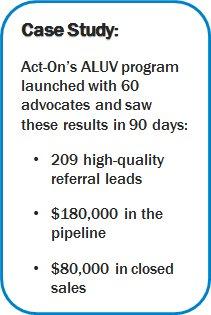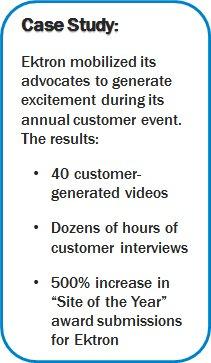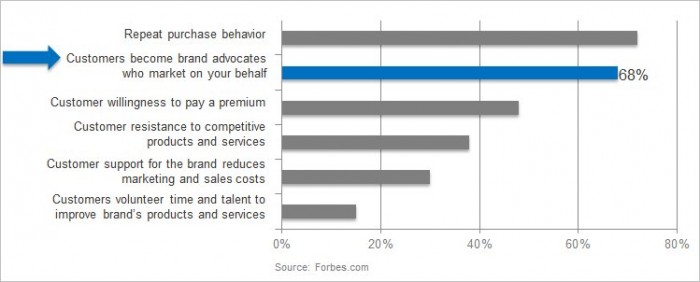Welcome to part deux of our 2-part series on advocacy marketing. In part 1 we answered two burning questions about the practice: What is advocacy marketing? and Why is it awesome? This installment will unpack the How (as in How is it done?) and provide some nuts and bolts that will help you build a solid advocacy marketing strategy.
Let’s start with …
A brief recap of part 1
What is advocacy marketing?
Advocacy marketing is a centuries-old (at least) practice commonly known as word-of-mouth (WOM) advertising. If you’re of a certain age, you might harken back to the Faberge Organics Shampoo commercials of the 1970s and 80s:
If you tell two friends, then they’ll tell two friends, and so on, and so on, and so on …
Ring a bell?
If not, suffice it to say that advocacy marketing is a strategy whereby people who like you (e.g., happy customers, employees, and partners) spread the word about your company, products, and services via their networks and communities.
In the digital age, the opportunities for tapping into the power of advocacy marketing are enormous. And that might be an understatement.
Why should you care?
Because buyers trust friends, family, colleagues, peers, and other respected influencers far more than they trust your brand.
- According to a new DemandGen study on B2B buyer behavior:
- 97% of B2B buyers give more credence to content that includes peer reviews.
- 72% of them use social media to research a purchase.
- 53% rely on peer recommendations to make a purchase.
- A Sprout Social survey says that 74% of consumers rely on their social networks to guide purchase decisions, and Lithium says the same percentage, 74%, use social media to encourage friends to try new products.
- Forrester Research reports that 85% of B2B decision-makers rely on online communities when researching business technologies.
The value of advocacy marketing comes down to the psychology of trust – simple as that. And if you can identify and strategically (and authentically) engage your advocates, you can leapfrog your current success metrics and milestones, including increasing demand, traffic, qualified leads, sales (both quantity and transaction size) and, by extension, revenue.
5 steps to building an advocacy marketing program
A caveat: The following steps are specifically focused on customer advocates; however, these steps can certainly be followed when creating other types of advocacy marketing, such as programs for employees, partners, fellow travelers, alumni, and investors.
Step 1: plan and get consensus
 This is the infamous 80% of the iceberg that’s hidden, bulky, cumbersome … and hugely critical. Planning focuses on defining, coordinating, and documenting the objectives, processes, people, and technologies that are involved in creating great opportunities and experiences that will turn customers into advocates.
This is the infamous 80% of the iceberg that’s hidden, bulky, cumbersome … and hugely critical. Planning focuses on defining, coordinating, and documenting the objectives, processes, people, and technologies that are involved in creating great opportunities and experiences that will turn customers into advocates.
It’s a big and necessary first step; without planning, there is no execution.
Here are key elements to consider when creating your plan:
- Who are your advocate personas?
- What are your strategic objectives for an advocacy program? For example:
- Increased revenue via customer referrals
- Shorter sales cycles
- Bigger deal sizes
- Increased web traffic
- Lower lead acquisition costs
- What are your operational objectives? For example:
- Total number of advocates in the program
- Total number who engage on a defined regular basis
- Total number of communications or “asks” completed in a defined timeframe
- Percentage of advocates who redeem rewards
- Percentage of advocates who opt out
- What deliverables do you want to get out of the program? For example:
- References
- Recommendations
- Reviews
- Social shares
- Case studies
- What are your viable campaign ideas (and how do they work and which objectives do they serve)? For example:
- Refer new customers
- Review products and services
- Participate in surveys/research
- Participate in beta programs
- Contribute content
- What are you going to measure and track? How?
Step 2: identify and onboard
After you’ve got a plan crafted and agreed to, the next step is to recruit your advocates. You should already have their personas nailed down, so now it’s a matter of finding them, and then making them an offer they can’t refuse.
Identify
How do you find them? According to Judy Logan, Act-On’s Director of Customer and Partner Marketing, “Start by talking to the people in your organization. Who talks to your customers most? It’s probably sales, and customer success and customer support. Leverage their knowledge and expertise. They’ll know who to contact.”
Onboard
Once you identify who you want to target, you need to reach out with one or more appealing opportunities/offers that will compel them to get on board with your program.
Your outreach plan should answer questions such as:
- What’s in it for our advocates?
- How can we position the program to appeal to/entice our target advocates?
- Which channels should be used to recruit and onboard them?
- How many advocates do we want from each channel in total? Per month? Per quarter?
NOTE: It’s important to launch an advocacy program with as many advocates on board as possible, rather than taking a cautious and incremental approach to program growth. Similar to a restaurant or store that has few (or zero) customers inside, people are less likely to enter a program that isn’t attracting a crowd. Conversely, if it’s bustling with members and activity, they’ll be more inclined to want a piece of the action.
 Next, create your outreach schedule. This includes:
Next, create your outreach schedule. This includes:
- Teaching internal teams (e.g., sales, customer success, customer support, etc.) the value of the program so they can have effective conversations when they communicate with potential or current advocates.
- Drafting the introductory pitch and invitations, ensuring the value is crystal clear, and the process for joining is quick, easy, and glitch-free.
- Creating at least 10 campaigns (e.g., complete this survey or review this product or become a subject matter expert in our forum) for your early advocates that allow them to engage immediately and, by extension, experience the program’s value.
- Soliciting feedback often. This is essential because feedback allows you to gauge the program’s performance and make improvements quickly. It also demonstrates that you are listening and responding to your advocates’ opinions and inputs. They won’t want to stay if you aren’t there too.
After a few iterations of the above tactics, your program will be increasingly positioned to scale up – more invitations, more campaigns, more advocates.
Step 3: engage
Engaging your advocates is just like engaging your prospects and leads: you use campaigns. In advocacy marketing, campaigns are often called “asks” because they’re used to request specific action from your pool of advocates. (Many of these might be on the list you brainstormed in Step 1.) For example, your campaigns may ask advocates to:
- Refer a new customer
- Take a survey
- Beta test a product or process
- Follow us
- Mention us
- Comment on blog posts
 Don’t get complacent here; that is, don’t assume your advocates are forever interested in and committed to your program merely because they signed up. If you don’t keep the romance alive, they’ll eventually grow bored and disengage, or walk away entirely.
Don’t get complacent here; that is, don’t assume your advocates are forever interested in and committed to your program merely because they signed up. If you don’t keep the romance alive, they’ll eventually grow bored and disengage, or walk away entirely.
Keep it fresh. Mix it up. Here are some ways:
- Motivate engagement by creating a sense of urgency. For example, add an expiration date (e.g., “Limited Time!”) coupled with the promise of a great gift or opportunity to spur higher (and quicker) advocate participation.
- Spice up the campaign variety. Don’t get into a rut of always asking for the same thing (take a survey is a common “ask” that can become tedious in a hurry). Vary your campaigns – both the “asks” and the designs/modes/channels – so they stay fresh. Incorporate the fun (videos, puzzles, trivia) with the serious (news, product information, and yes … surveys).
- Don’t make every campaign an “ask.” Think about it: It becomes deflating and annoying when someone you like contacts you only when they need a favor, right? It’s the same thing for your advocates. Make it a two-way relationship.
Step 4: recognize and reward
There’s a wonderful economics term that summarizes this step: incentive compatibility.
In other words, what motivates your advocates to stay in your program and, more importantly, to spend time and energy engaging with you and with their networks on your behalf?
For the most part, your advocates stick around because they like you, believe in your brand or products or values, and enjoy a sense of connection and partnership. But like all of us, they also want to know they’re appreciated.
 Among the many incentives that drive people to action, the following four are considered the most important and should be the basis of your program’s recognition and rewards:
Among the many incentives that drive people to action, the following four are considered the most important and should be the basis of your program’s recognition and rewards:
- Status. This is public recognition for one’s efforts and it’s the most desired incentive. Examples of how to use status as a level of reward include recognizing an advocate at a customer event, offering them speaking opportunities, showcasing them on your website, or including them in high-value content (e.g., a case study).
- Access. Getting unique access to something that most others don’t get is a mighty appealing incentive that can be a successful driver of continued advocate engagement. Some ideas include the opportunity to take part in a new initiative, receive a “backstage pass” at a key event, or be invited to cocktails or dinner with the C-suite.
- Power. In the case of advocacy marketing, power means having a higher level of impact than merely providing feedback. For example, an advocate might contribute to the product roadmap, be a guest blogger, or become a go-to consultant.
- Stuff. This is the bling, the swag, the giveaways – from t-shirts and pens to discounts and gift cards to solid-state drives and tablets – that can drive a lot participation in a short amount of time. They should be used in moderation, otherwise you risk attracting and keeping a lower value of advocate than you want.
Step 5: measure and analyze
You can’t improve, fix, or optimize what you don’t measure. Like every other type of marketing strategy, you should measure your advocacy programs and always tie it back to your business objectives.
Here are some essentials metrics:
- Advocate conversion rates
- Participation rates per campaign, channel
- Engagement rates
- Number of advocate-referred leads
- Conversion rate of advocate-referred leads
- Average value of advocate-referred deals
- Revenue influence/attribution (set up a scoring system that gauges the impact each advocate has on your revenue streams)
- Rate of renewals, repurchases, upsells by advocates
- Number of deliverables from your advocates, e.g.:
- References
- Reviews
- Testimonials
- Recommendations
- Social shares
With good data in at your disposal, you can optimize your campaigns, continually improve and expand your program, and definitively see the value your advocates contribute to revenue.
68% say advocacy is integral to company success
That’s according to a Forbes study wherein 300 marketing leaders answered this question: Which of the following results are integral to your definition of successful customer engagement?
Here’s the chart:
Advocacy marketing is a proven strategy for gaining tremendous business upside. If you haven’t entertained the option, do. If you have an advocacy program in place, keep it going. The power of advocacy marketing has worked in business’s favor for centuries. In the digital age, the potential is that much greater.
"Iceberg photomontage" by Uwe Kils, used under GNU free documentation license.


